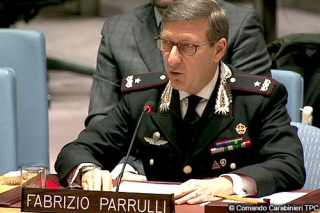The second G7 Roma-Lyon Group meeting was held in Rome from 3 to 5 October. This work group, created under the 2001 G8 Italian Presidency, is run by the law enforcement sector and is devoted to formulating counter-terrorism strategies and combating transnational crimes.
Brigadier General Fabrizio Parrulli, Commander of the Carabinieri Headquarters for the Protection of the Cultural Heritage (TPC), opened the proceedings.
ICCROM participated in the first day’s Expert Group Meeting: “Cultural Heritage, the Mirror of Identity” on cataloguing, collecting and sharing data for the protection of cultural heritage and the art market.
Delegates from the G7 countries and experts from international organizations attending the meeting called for maximum co-operation to end the illicit trafficking of antiquities from Syria, Iraq and beyond.
On the occasion of this meeting, ICCROM’s Director-General, Dr Stefano De Caro, observed, “This important event reaffirms the engagement of the G7 nations in the protection and restoration of cultural heritage endangered by conflicts and natural disasters. ICCROM welcomes and supports all such international collaboration efforts in favour of protection for cultural heritage and for those charged with stewarding it.”
How much is the black market worth?
Illegal traffic in the art world has a value of $8 billion a year, with annual revenues for cultural goods traffic of $1.8 to $1.6 billion, explained Edouard Planche, UNESCO delegate, reporting the estimates of the Global Financial Integrity “Transnational Crime and the Developing World” 2017 report. A survey conducted by SAFE reveals that of 2,358 archaeologists interviewed, 97.9% argue that the looting of archaeological sites is an existing phenomenon and 78.5% have experienced it personally.
The Carabinieri, the foreign police, EUROPOL and INTERPOL agree to consider illicit trafficking of art goods as an organized crime, in the meaning adopted by the Palermo Convention. The TPC Carabinieri survey results show that more than half of the G7 states consider the illicit trafficking of cultural goods as a serious offense, while 10% prefer to assess the nature of the offense case by case.
Traffic routes
The convergence of routes of illicit trafficking of cultural goods from Syria and Iraq to areas of North America, Southeast Asia, and Europe shows that the G7 countries are mostly “market countries” for illicit goods. In these states there is also a general absence of the needed activity of monitoring channels or places where illegal exchanges occur more frequently, such as antiques or galleries. Brigadier General Parrulli – in the face of data indicating that 33% of G7 countries have evidence of the effective funding that the Islamic State derives from the black market for art goods – considered it appropriate to increase intelligence controls, surveys and cooperation between states for data-sharing, and also to leverage synergies between governments and the private sector.
ICOM Vice President Alberto Garlandini addressed the crucial role that public and private museums can and must play in the fight against the illicit traffic of art goods. The ICOM Code of Ethics for Museums requires the affiliated museums to undertake due diligence in the event of the purchase of any new artwork, loan, donation or testamentary legacy, paying close attention so as not to purchase items on the ICOM Red Lists. For museums in crisis areas, it is increasingly essential to quickly catalogue artifacts belonging to collections through the international standard of ObjectID and through the activation of the Museum Emergency Program (MEP), implemented in collaboration with ICCROM and the International Blue Shield Committee.
“Without the fundamental work of the Team,” said Marina Schneider, UNIDROIT Senior Legal Officer, “we would not have today the Security Council Resolutions, in particular 2199 of 2015 (on the subject of funding for activities and the very existence of terrorist groups), and 2347 of 2017 (which has the object of countering illegal trade in cultural goods in relation to situations of armed conflict or acts committed by terrorist groups), not to mention the Convention of the Council of Europe, Europe on cultural property offenses, or the European Commission’s proposal to regulate the illicit import of art goods.”
The huge volume of clandestine trade in cultural goods, the degeneration of the art market and the source of financing of terrorist organizations, already discussed at the G7 Culture meeting, and more recently on 20-21 September at the UN General Assembly, New York, requires a reflection on what has been done and how much can still be done. The technical approach with which the issue has been addressed and the immediate prospect of future plans confirm the main function of the Roma-Lyon Group. These include constantly updating coordination between the G7 nations, providing for the formulation of shared projects, and responding to the threats appearing in an increasingly globalized world.
“We Protect Our History – Buy Objects with a History” is the appeal launched by Brigadier General Parrulli at the end of the meeting.

